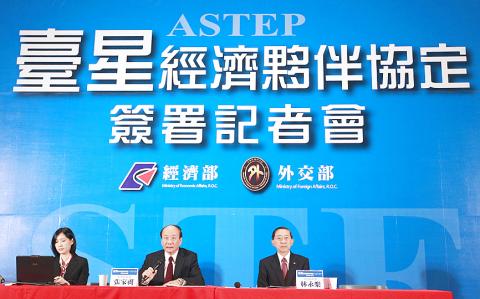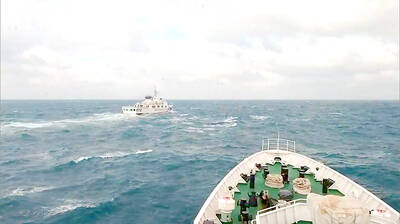Taiwan yesterday signed a far-reaching free-trade agreement (FTA) with Singapore — the first of its kind with a Southeast Asian country — in a move the government said would boost the nation’s efforts to pursue further economic engagement with trading partners bilaterally and multilaterally.
“This is a milestone achievement for Taiwan’s progress toward economic liberalization and our participation in regional economic integration,” Minister of Economic Affairs Chang Chia-juch (張家祝) told a press conference at 11am in Taipei.
Minister of Foreign Affairs David Lin (林永樂) said the agreement demonstrated Taiwan’s commitment to trade and investment liberalization to the global community.

Photo: Pichi Chuang, Reuters
The agreement “serves as an example” for Taiwan’s negotiation with other countries to sign economic cooperation agreements, Lin said.
“It could also trigger a domino effect” by encouraging other countries to open talks with Taiwan on similar trade accords, Lin added.
The pact — called the Agreement between Singapore and the Separate Customs Territory of Taiwan, Penghu, Kinmen and Matsu on Economic Partnership (ASTEP) — was signed by Representative to Singapore Fadah Hsieh (謝發達) and Singaporean Trade Representative to Taiwan Calvin Eu at a ceremony held at 9:30am in Singapore.
With Beijing’s insistence that FTAs can only be concluded among sovereign states, Taiwan has to conclude FTA-like agreements under a different name, such as the Agreement between New Zealand and the Separate Customs Territory of Taiwan, Penghu, Kinmen and Matsu on Economic Cooperation signed in August.
The exceptions are the four FTAs that Taiwan has with five diplomatic allies in Central America — Panama, Guatemala, Nicaragua, El Salvador and Honduras.
Billed by the government as a comprehensive, “high-standard” and “high-quality” trade agreement, the ASTEP contains 17 chapters, covering market access conditions for trade in goods, cross-border trade in services, government procurement and e-commerce; issues related to trade rules — technical barriers to trade, rules of origin, foreign investment, competition policies, trade remedies, customs procedures, sanitary and phytosanitary measures, and transparency; cooperation in intellectual property protection; and dispute settlement provisions.
Taiwan will remove 99.48 percent of its tariff lines within 15 years at the latest, with the exception of 40 agricultural products, including rice, mangoes, garlic, shiitake mushrooms, red beans, shelled ground-nuts and liquid milk.
Once the agreement takes effect, expected early next year, Taiwan will provide Singapore immediate tariff-free access to 65.97 percent of its agricultural products and 87.39 percent of its industrial products, while duties on the rest of the products will be reduced in three stages over a 15-year period.
The tariff cuts will have a limited impact on Taiwan’s agricultural sector because Singapore is not an agriculture-based economy, he said.
Chang added that throughout the two-and-a-half years of negotiations, Taiwan pressed for a longer tariff phase-out period to give less-competitive, domestic-oriented industries, such as auto parts, engines, motorcycles, towels and cotton clothing, time to adjust.
In return, Singapore, which has a very open trading regime that levies tariffs on only six beverage products, extended zero tariffs to all imports from Taiwan.
Both countries also agreed to adopt a “negative list” — as opposed to the “positive list” used in the WTO’s General Agreement on Trade in Services — to provide greater market access to investors from the other country. Under this set-up, the two countries agreed to open all their service sectors, unless specifically excluded by each country in an annex to the agreement.
Taiwan’s negative investment list covers 30 sectors in transportation, telecommunication and professional services, while Singapore has 35 sectors on its list related to healthcare and transportation, among others.
Both countries agreed to go beyond their respective WTO commitments in certain service sectors, including research and development service, general engineering and Type I telecommunications enterprises, while applying their commitments under the WTO to the finance industry under the bilateral agreement.
The agreement is expected to add US$701 million to Taiwan’s GDP over the next 15 years, boosting domestic output by NT$42.1 billion (US$1.43 billion) and creating 6,154 jobs, Chang said, citing a study conducted by the Chung-Hua Institution for Economic Research (中華經濟研究院).
Lin said that aside from signing FTAs with its main trade partners, Taiwan’s ultimate goal is to participate in regional economic integration through agreements such as the Trans-Pacific Partnership (TPP) and the Regional Comprehensive Economic Partnership (RCEP) — both possible pathways to the formation of an Asia-Pacific free-trade area.
“We will contact each member involved in TPP and RCEP negotiations and conclude agreements with them one by one,” Lin said.
Taiwan has completed feasibility studies on signing FTA-like pacts with India and Indonesia. Another one on trade with the Philippines is expected to be completed in the near future, Lin said.

Auckland rang in 2026 with a downtown fireworks display launched from New Zealand’s tallest structure, Sky Tower, making it the first major city to greet the new year at a celebration dampened by rain, while crowds in Taipei braved the elements to watch Taipei 101’s display. South Pacific countries are the first to bid farewell to 2025. Clocks struck midnight in Auckland, with a population of 1.7 million, 18 hours before the famous ball was to drop in New York’s Times Square. The five-minute display involved 3,500 fireworks launched from the 240m Sky Tower. Smaller community events were canceled across New Zealand’s

The Ministry of Foreign Affairs (MOFA) yesterday said it is closely monitoring developments in Venezuela, and would continue to cooperate with democratic allies and work together for regional and global security, stability, and prosperity. The remarks came after the US on Saturday launched a series of airstrikes in Venezuela and kidnapped Venezuelan President Nicolas Maduro, who was later flown to New York along with his wife. The pair face US charges related to drug trafficking and alleged cooperation with gangs designated as terrorist organizations. Maduro has denied the allegations. The ministry said that it is closely monitoring the political and economic situation

‘SLICING METHOD’: In the event of a blockade, the China Coast Guard would intercept Taiwanese ships while its navy would seek to deter foreign intervention China’s military drills around Taiwan this week signaled potential strategies to cut the nation off from energy supplies and foreign military assistance, a US think tank report said. The Chinese People’s Liberation Army (PLA) conducted what it called “Justice Mission 2025” exercises from Monday to Tuesday in five maritime zones and airspace around Taiwan, calling them a warning to “Taiwanese independence” forces. In a report released on Wednesday, the Institute for the Study of War said the exercises effectively simulated blocking shipping routes to major port cities, including Kaohsiung, Keelung and Hualien. Taiwan would be highly vulnerable under such a blockade, because it

UNRELENTING: China attempted cyberattacks on Taiwan’s critical infrastructure 2.63 million times per day last year, up from 1.23 million in 2023, the NSB said China’s cyberarmy has long engaged in cyberattacks against Taiwan’s critical infrastructure, employing diverse and evolving tactics, the National Security Bureau (NSB) said yesterday, adding that cyberattacks on critical energy infrastructure last year increased 10-fold compared with the previous year. The NSB yesterday released a report titled Analysis on China’s Cyber Threats to Taiwan’s Critical Infrastructure in 2025, outlining the number of cyberattacks, major tactics and hacker groups. Taiwan’s national intelligence community identified a large number of cybersecurity incidents last year, the bureau said in a statement. China’s cyberarmy last year launched an average of 2.63 million intrusion attempts per day targeting Taiwan’s critical